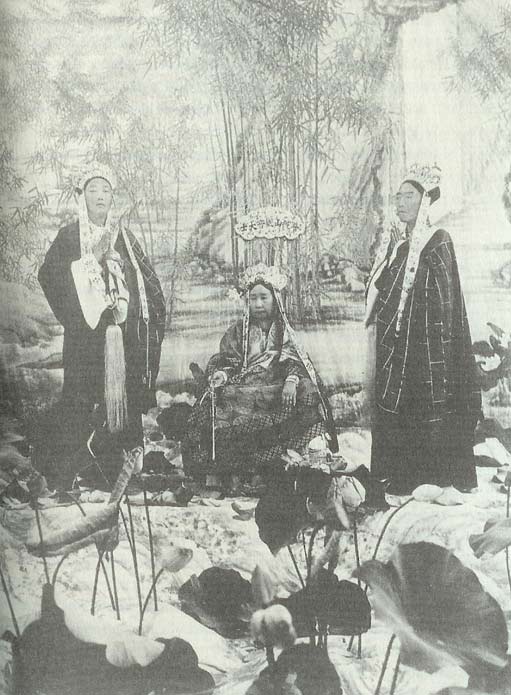This is a picture of the Empress Dowager Cixi

She is shown in the guise of Guanyin attended by two of her eunuchs in the guise of bodhisattvas. 1 According to Princess Der Ling, Cixi explained her motivation for having this photo taken as such..
“Whenever I have been angry, or worried over anything by dressing up as the Goddess of Mercy it helps me to calm myself, and so play the part I represent. I can assure you that it does help me a great deal, as it makes me remember that I am looked upon as being all-merciful. By having a photograph taken of myself dressed in this consume, I shall be able to see myself as I ought to be at all times.”
Liu points out that it is interesting that Cixi chose to see herself as Guanyin, a deity of confusing gender, since as a ruling empress she was also violating gender conventions.2 I find it a bit more interesting that this is the most explicit case I have seen of imperial spectacle aimed at the ruler themselves. Imperial and royal spectacle is usually studied on the assumption that the audience was the populace or the court or the citizenry or something. One obvious hard to study audience is the ruler themselves. Chinese imperial ritual was intended to constrain as much as to empower the ruler, emperors were probably aware of this, but their reaction to the ritual is hard to know.
Cixi’s was a private spectacle aimed only at herself and apparently intended to make it possible for her to always remind herself of her attribute of benevolence. It is thus an aid in a sort of Confucian (or maybe Buddhist) process of self-cultivation. It is a physical aid in self-cultivation, much like the ledgers of merit and demerit, or possibly a mandala, focusing on which is also supposed to help one attain a mental state. It seems to be something that she came up with on her own, which figures given that a proper Han court ritual would not involve Buddhism, and a Manchu ritual would, I think, not involve Guanyin.
1 From Lydia Liu’s The Clash of Empires: The Invention of China in Modern World Making p.163
2 I’m not sure if Cixi would have seen in that way. Liu points out something that is pretty general knowledge among scholars that in India Avalokitesvara was male, and then gradually became female in China. Would this have been known to Cixi?
I am not sure that it is correct to describe Guan Yin (Kannon in Japanese)as a deity or even as the ‘Goddess of Mercy’. The concept of bhuddahood and the western concept of godhood are totally different. There is no original title that correspond to the translation ‘Goddess of Mercy’. The ‘Goddess of Mercy’ title is thus a mistranslation of a misinterpreted concept.
It would be good to have other people’s knowledge of this posted here.
Yes, Guan Yin is not really a goddess in the sense the word is used in the west, but it is a pretty standard translation. At some point if you are going to translate anything you need to accept a certain amount of inaccuracy. 王 does not mean the same thing as King, in the Western, Christian sense, but it works as a translation.
Alan Baumler;
But ‘wang’ does correspond to the Western, Christian ‘King’. ‘Wang’ also corresponds to any non-Western and non-Christian ‘King’. ‘Wang’ also corresponds to ‘king’ (small k), Prince, prince, Grand Duke, Duke, Tsar, Czar, Shah, Sultan, sovereign, or whatever title a ruling house uses. The context dictates the corresponding translation in its correct form. This rule is also generally true of European ruling houses. If one were to print out the full title of a European sovereign, it could take several pages; but the title is simply shortened to King or Queen or Prince, etc. There being two types of queens: Queen Sovereign and Queen Consort, both taking the title and address of ‘Queen’. The context dictates which queen the person is. There is no doubt that the translation of ‘wang’ to ‘king’ is correct, because the 2 words could be translated back and forth without the loss of meaning.
However, to translate ‘Guan Yin’ as the ‘Goddess of Mercy’ is totally incorrect. I have reversed translated ‘Goddess of Mercy’ and have never found a Chinese person who equated this term with ‘Guan Yin’. This term may be pretty standard to you, but not at all standard or known to the ordinary Chinese. Imagine telling a Roman Catholic that from today someone of another culture will call their Mary-Mother-of-God, ‘Goddess’, or to bestow such title on her. This culture may well have thought it was bestowing a compliment upon the Roman Catholic religion, but the Pope would definitely not allow such a ‘gift’. As to equating ‘Goddess’ to a Christian term, this is totally unacceptable, because there are no goddesses at all in the theology of Christianity or Judaism. A ‘goddess’ in the Western sense, is equated to a ‘goddess’ of the ancient Greek or Roman civilisation. A ‘goddess’ in the mythology of these cultures could and did breed with mortal men, somthing which is totally sacrilegious when compared with Guan Yin.
I do not know who first coined the term ‘Goddess of Mercy’ for Guan Yin, but it is not correct. If it were a mistranslation, then it is appropriate to put a correction to it. I cannot accept inaccurate translations. People who accept and propagate mistranslations across languages do not demonstrate any scholarly credibility or integrity. Mistranslations of languages cause misunderstanding, animosity and hatred among people of different cultures and histories. No doubt as historians you are fully aware of this; and if there are any lessons to be learnt from history, it is that we should stop and prevent these inaccuracies from spreading rather than propagate them.